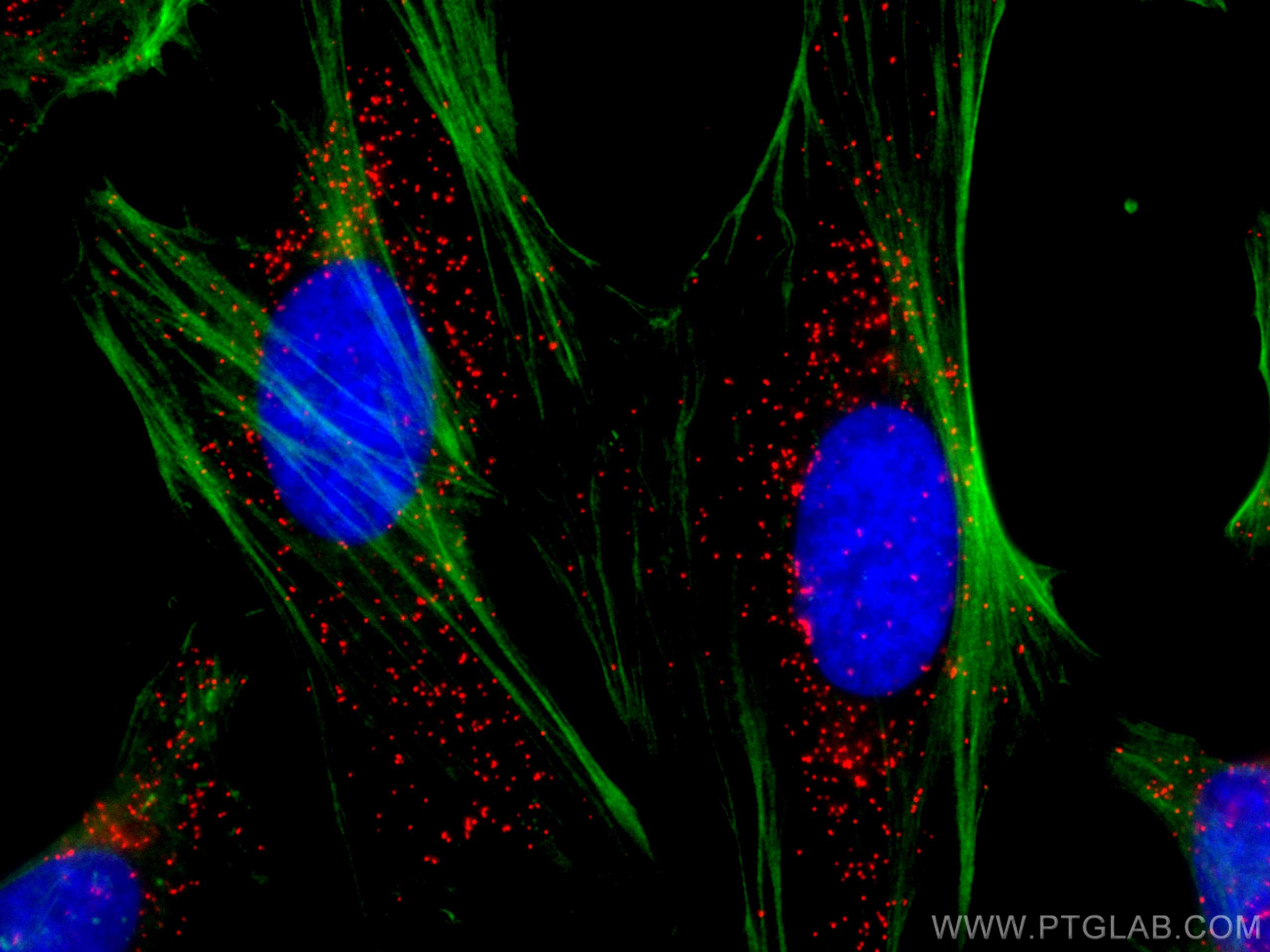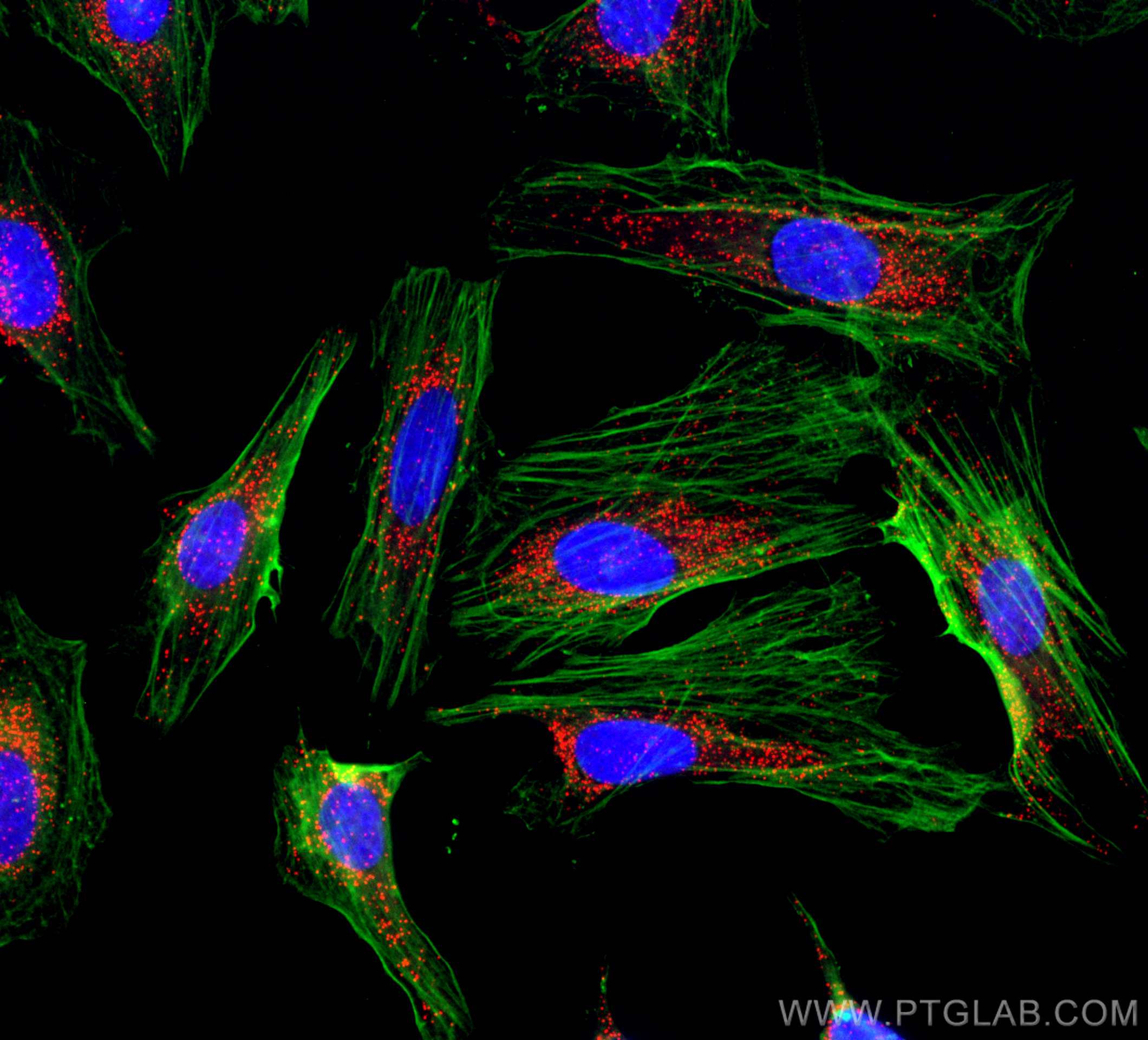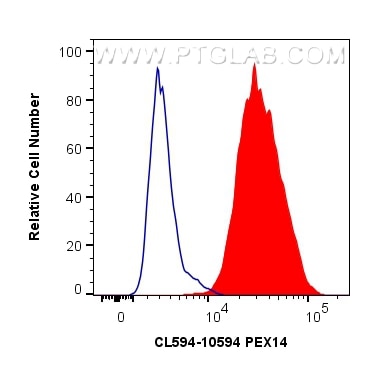Validation Data Gallery
Tested Applications
| Positive IF/ICC detected in | HeLa cells |
| Positive FC (Intra) detected in | HeLa cells |
Recommended dilution
| Application | Dilution |
|---|---|
| Immunofluorescence (IF)/ICC | IF/ICC : 1:200-1:800 |
| Flow Cytometry (FC) (INTRA) | FC (INTRA) : 0.80 ug per 10^6 cells in a 100 µl suspension |
| It is recommended that this reagent should be titrated in each testing system to obtain optimal results. | |
| Sample-dependent, Check data in validation data gallery. | |
Published Applications
| IF | See 9 publications below |
Product Information
CL594-10594 targets PEX14 in IF/ICC, FC (Intra) applications and shows reactivity with human, mouse, rat samples.
| Tested Reactivity | human, mouse, rat |
| Cited Reactivity | human, mouse, rat |
| Host / Isotype | Rabbit / IgG |
| Class | Polyclonal |
| Type | Antibody |
| Immunogen |
CatNo: Ag0932 Product name: Recombinant human PEX14 protein Source: e coli.-derived, PGEX-4T Tag: GST Domain: 77-377 aa of BC006327 Sequence: PSSLGPATQVVPVQPPHLISQPYSPAGSRWRDYGALAIIMAGIAFGFHQLYKKYLLPLILGGREDRKQLERMEAGLSELSGSVAQTVTQLQTTLASVQELLIQQQQKIQELAHELAAAKATTSTNWILESQNINELKSEINSLKGLLLNRRQFPPSPSAPKIPSWQIPVKSPSPSSPAAVNHHSSSDISPVSNESTSSSPGKEGHSPEGSTVTYHLLGPQEEGEGVVDVKGQVRMEVQGEEEKREDKEDEEDEEDDDVSHVDEEDCLGVQREDRRGGDGQINEQVEKLRRPEGASNESERD 相同性解析による交差性が予測される生物種 |
| Full Name | peroxisomal biogenesis factor 14 |
| Calculated molecular weight | 41 kDa |
| Observed molecular weight | 57 kDa |
| GenBank accession number | BC006327 |
| Gene Symbol | PEX14 |
| Gene ID (NCBI) | 5195 |
| RRID | AB_2919739 |
| Conjugate | CoraLite®594 Fluorescent Dye |
| Excitation/Emission maxima wavelengths | 588 nm / 604 nm |
| Form | |
| Form | Liquid |
| Purification Method | Antigen affinity purification |
| UNIPROT ID | O75381 |
| Storage Buffer | PBS with 50% glycerol, 0.05% Proclin300, 0.5% BSA{{ptg:BufferTemp}}7.3 |
| Storage Conditions | Store at -20°C. Avoid exposure to light. Stable for one year after shipment. Aliquoting is unnecessary for -20oC storage. |
Background Information
PEX14 (peroxisomal biogenesis factor 14) is a peroxisomal membrane protein that is essential for protein docking onto the peroxisomes. It is a central component of the peroxisimal matrix protein import machinery and interacts with PEX5 and PEX19. PEX14 is ubiquitously expressed and defects in PEX14 are the cause of peroxisome biogenesis disorder complementation group K (PBD-CGK). This antibody can be used to detect endogenous PEX14 with an apparent molecular weight of 57 kDa (PMID: 16449325; 9653144) and recognize peroxisomal structures in human, monkey and mouse cells.
Protocols
| Product Specific Protocols | |
|---|---|
| FC protocol for CL594 PEX14 antibody CL594-10594 | Download protocol |
| IF protocol for CL594 PEX14 antibody CL594-10594 | Download protocol |
| Standard Protocols | |
|---|---|
| Click here to view our Standard Protocols |
Publications
| Species | Application | Title |
|---|---|---|
J Neuroinflammation TRIM45 aggravates microglia pyroptosis via Atg5/NLRP3 axis in septic encephalopathy | ||
Mol Neurobiol Schwann Cell-Derived Exosomes Ameliorate Paclitaxel-Induced Peripheral Neuropathy Through the miR-21-Mediated PTEN Signaling Pathway | ||
Science Macrophage peroxisomes guide alveolar regeneration and limit SARS-CoV-2 tissue sequelae | ||
Inflamm Res GCH1 reduces LPS-induced alveolar macrophage polarization and inflammation by inhibition of ferroptosis | ||
J Ethnopharmacol TMT quantitative proteomics and network pharmacology reveal the mechanism by which asiaticoside regulates the JAK2/STAT3 signaling pathway to inhibit peritoneal fibrosis | ||



